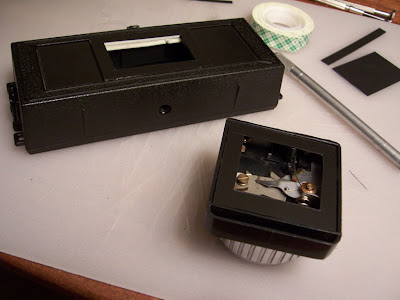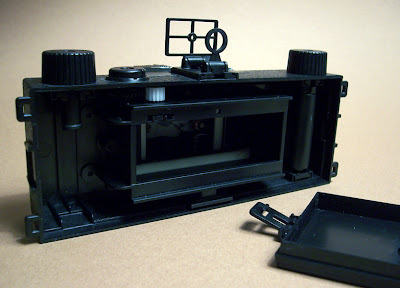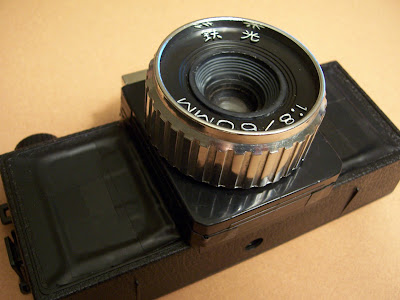There is this great series of magazine/kits from Japan called Gakken. I had previously bought a pinhole camera kit produced by them.

Neat camera...came with a lens as well so you can use it as a regular 35mm camera. More recently, they released a kit pinhole 3D/pano camera...which I had to have, of course.

Again, this is a kit, so I put this together from a box of parts and an instruction sheet all in Japanese. It was actually relatively easy to assemble...only a few gears and such, and none of the typical Ikea "one part doesn't fit right" syndrome. Right off, I knew this was an ideal base for my Pano Holga. But I've had it for a year...I couldn't decide if I wanted to sacrifice such a cool little camera to my project. I've only used it once, though. Nice results, but I'm just too lazy to do pinhole stuff on a regular basis. This is a shot of an abandoned house taken in pinhole panoramic mode.

Nice stuff, and you get an idea of how long the image really is with this pano. I think I actually cropped some dark from the sides as well. I finally decided I really wanted to make this camera.
First thing was to take the pinhole apart. I wanted to do it without ruining anything, so I pretty much had to reverse back to halfway built and then reattach some stuff.

Now for the Holga. Well, I have two, a 120SF and a 120GN. I didn't want to ruin the flash connection on the 120SF, so that was out. I haven't used my 120GN yet, so that was out as well. I do have some extra Holga lens elements, but I really want a shutter mechanism and the ability to focus. Hmmm...
Last Spring, I ordered a bunch of plastic cameras from mainland China. You rarely see these outside of China, so most people probably don't know that the Holga isn't all that original. The design seems to be taken from a basic camera design used frequently with cheapo Chinese 120 cameras. I now have about six variations on this design...they all look pretty much like the Holga, except for the shutter release mechanism. And they pull apart just like a Holga. Three screws on the inside and you have the front off. I decided to use one of these as they generally produce the same results as the holga (maybe a bit softer and blurrier for some). I decided to use this one, as it is missing the stickers from the front.

See? Looks like a Holga with chrome. Here is a shot taken with the camera.

Can't believe I couldn't wait three seconds for the truck to drive by. Oh well. But you see it has great blur...should fall off nicely along the edges of a 35mm pano shot. So I removed the three screws to get the lens and shutter.

Then I built my camera! First I had to cover that open area on the pano camera.

I used two layers of double-sided tape to bring the level up and to stick the front on.


You can see what I'm going for here...

Needed to raise up the front and create an area to stick the front to the body (using more double-sided tape).



I was really hoping to not use much black electrical tape, but the camera wasn't just a little leaky...it was a lot leaky. That double-sided foam tape is practically transparent. Light shines right through it. So tape it I did. Stuck the front on with more double-sided. I wanted it to be firm so the front wouldn't pop off when I fired the shutter.

More tape and we have a working camera! A little camera porn for you.



Here you see how long the image is. About 2.5 times the length of a regular 35mm shot.

The advancing mechanism on top shows you when to stop turning the knob. That little black knob with the notch goes one full rotation per shot. No counter, but you just stop shooting when the film stops advancing. Rewind with the other knob. Easy enough!

Has a tripod mount, which is useful for pinholes, of course.

There she is...my new Qumei 35mmm Pano. And the focal length is the same as the original toy, so no focusing worries.

Not pretty but she's great in bed. I hope...I haven't actually taken her to bed yet. I'm going to California for a couple days next week, will take it for a spin. Also have a new Kowa Six to try out. And I found a copy of the instruction booklet for my Polaroid 180. So now I finally understand the EV system. So simple, it's like 'duh', but I learn new things all the time. Now I can mess around with wider apertures on my 180 and 195 without wasting polas trying to set the exposure.
So check back for results! In the future, I plan on reviewing the Kowa Six, and comparing the 180 and 195. I also am expecting a Black Bird Fly in the next few...another new camera to use! AND...geez, I need to stop...I picked up a Polaroid Spectra with three packs of film for seven bucks! More camera goodness. Until whenever...












